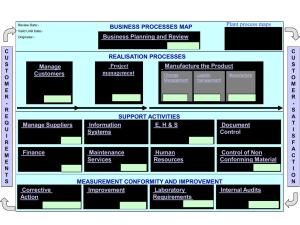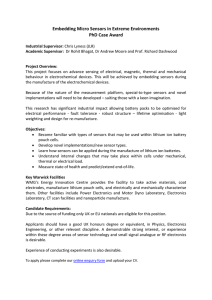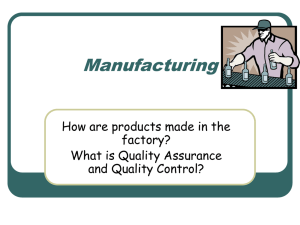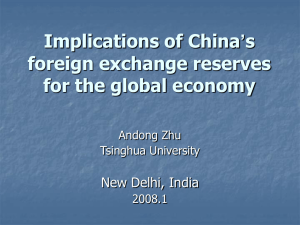The changing face of manufacturing O by
advertisement
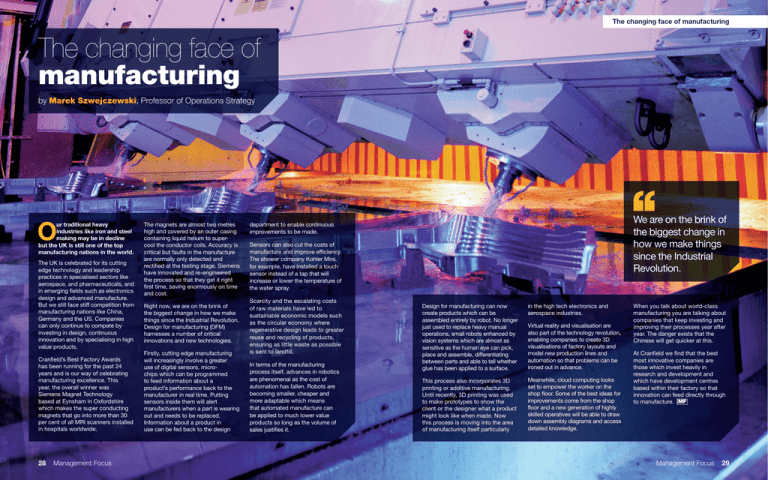
The changing face of manufacturing The changing face of manufacturing by Marek Szwejczewski, Professor of Operations Strategy O ur traditional heavy industries like iron and steel making may be in decline but the UK is still one of the top manufacturing nations in the world. The UK is celebrated for its cutting edge technology and leadership practices in specialised sectors like aerospace, and pharmaceuticals, and in emerging fields such as electronics design and advanced manufacture. But we still face stiff competition from manufacturing nations like China, Germany and the US. Companies can only continue to compete by investing in design, continuous innovation and by specialising in high value products. Cranfield’s Best Factory Awards has been running for the past 24 years and is our way of celebrating manufacturing excellence. This year, the overall winner was Siemens Magnet Technology based at Eynsham in Oxfordshire which makes the super conducting magnets that go into more than 30 per cent of all MRI scanners installed in hospitals worldwide. 28 Management Focus The magnets are almost two metres high and covered by an outer casing containing liquid helium to supercool the conductor coils. Accuracy is critical but faults in the manufacture are normally only detected and rectified at the testing stage. Siemens have innovated and re-engineered the process so that they get it right first time, saving enormously on time and cost. Right now, we are on the brink of the biggest change in how we make things since the Industrial Revolution. Design for manufacturing (DFM) harnesses a number of critical innovations and new technologies. Firstly, cutting edge manufacturing will increasingly involve a greater use of digital sensors, microchips which can be programmed to feed information about a product’s performance back to the manufacturer in real time. Putting sensors inside them will alert manufacturers when a part is wearing out and needs to be replaced. Information about a product in use can be fed back to the design We are on the brink of the biggest change in how we make things since the Industrial Revolution. department to enable continuous improvements to be made. Sensors can also cut the costs of manufacture and improve efficiency. The shower company Kohler Mira, for example, have installed a touch sensor instead of a tap that will increase or lower the temperature of the water spray. Scarcity and the escalating costs of raw materials have led to sustainable economic models such as the circular economy where regenerative design leads to greater reuse and recycling of products, ensuring as little waste as possible is sent to landfill. In terms of the manufacturing process itself, advances in robotics are phenomenal as the cost of automation has fallen. Robots are becoming smaller, cheaper and more adaptable which means that automated manufacture can be applied to much lower value products so long as the volume of sales justifies it. Design for manufacturing can now create products which can be assembled entirely by robot. No longer just used to replace heavy manual operations, small robots enhanced by vision systems which are almost as sensitive as the human eye can pick, place and assemble, differentiating between parts and able to tell whether glue has been applied to a surface. in the high tech electronics and aerospace industries. This process also incorporates 3D printing or additive manufacturing. Until recently, 3D printing was used to make prototypes to show the client or the designer what a product might look like when made. Now this process is moving into the area of manufacturing itself particularly Meanwhile, cloud computing looks set to empower the worker on the shop floor. Some of the best ideas for improvements come from the shop floor and a new generation of highly skilled operatives will be able to draw down assembly diagrams and access detailed knowledge. Virtual reality and visualisation are also part of the technology revolution, enabling companies to create 3D visualisations of factory layouts and model new production lines and automation so that problems can be ironed out in advance. When you talk about world-class manufacturing you are talking about companies that keep investing and improving their processes year after year. The danger exists that the Chinese will get quicker at this. At Cranfield we find that the best most innovative companies are those which invest heavily in research and development and which have development centres based within their factory so that innovation can feed directly through to manufacture. MF Management Focus 29



